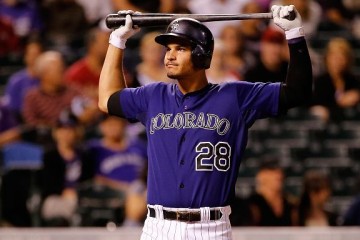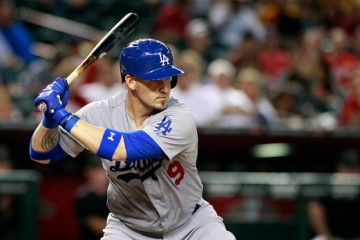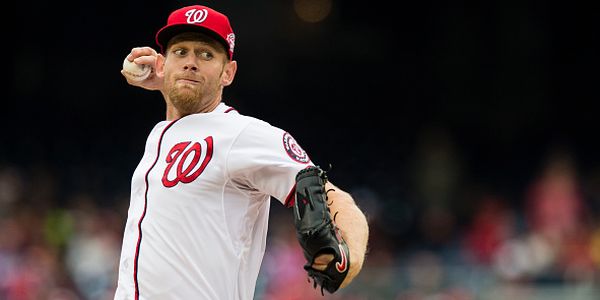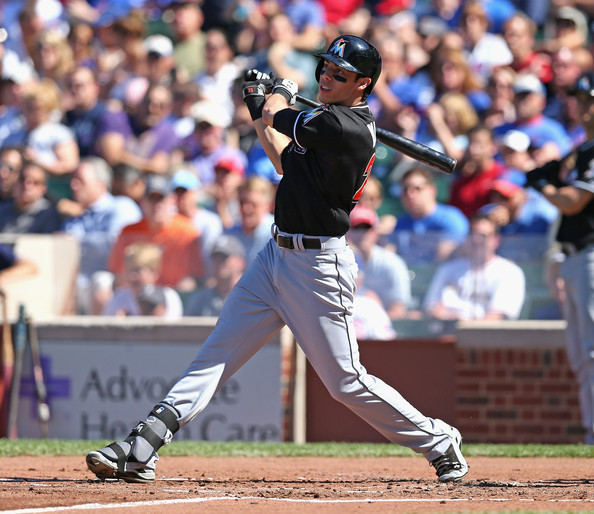2016 Fantasy Baseball Waiver Wire: 3 to Catch, 3 to Cut, 3 to Keep (Week 13)
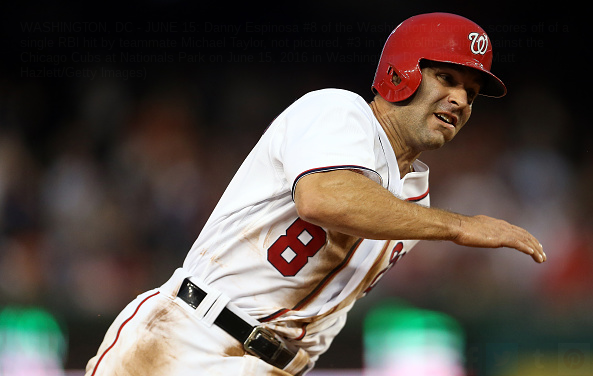
In the newest edition of fantasy baseball 3×3, we’re peaking with Danny Espinosa, interrogating Eugenio Suarez, and doubling down on Willson Contreras.
Thoughts, questions, whatever… you can always find me on Twitter.
3 TO CATCH
Players to be picked up; available in most standard leagues
Danny Espinosa | Washington Nationals | 2B/SS
We are witnessing peak Danny Espinosa right now. It takes a special kind of nerd to be intrigued by that sentence, but in the words of Bill Simmons: “Yep, those are my readers”.
If you’re working through an injury or plugging a gap at just about any position, Espinosa is a fantastic short term fill-in. He has perfected the all-or-nothing power approach that makes him a truly unique fantasy asset, hammering 13 home runs with a .192 ISO. We all lost our minds watching Trevor Story do this in April; Espinosa is just a more advanced (and admittedly less talented) version who’s available in almost 80% of fantasy leagues.
He’s never showed better plate discipline and never hit more fly balls; his 46.3% fly ball rate just barely trails sluggers like Chris Davis, Chris Carter, and Adam Duvall; Espinosa is one of only ten hitters to loft more than 45% of his batted balls in the air and at hit least 17% of those balls over the fence. It’s not an approach that’ll yield much in the batting average department, but Espinosa was never a particularly capable contact hitter in the first place.
This version of Espinosa is the best version there is.
This doubles as a “wait a while” recommendation on Trea Turner. As long as Espinosa is raking, the Nationals will keep disappointing fantasy owners who thought they were ahead of the prospect acquisition curve.
To pick him up, I’d drop: Eugenio Suarez, Whitt Merrifield, Brandon Phillips
Matt Shoemaker | Los Angeles Angels | SP
Matt Shoemaker is a risky proposition, but especially for fantasy owners in head-to-head leagues, the improvement he’s shown in the last month is enough to make him a worthwhile gamble. Among qualified starters, only Clayton Kershaw has a better swinging strike rate over the last 30 days. And since Kershaw is obviously an alien sent here to embarrass major league baseball players, you could say that Shoemaker has missed more bats than any human starter over the last month.
That video is a perfect summation of Shoemaker, who delivers a combination of bat-missing stuff and weak contact, sandwiched around a few very hittable mistakes. Admit it, you thought that ball that Didi Gregorious hit, a lazy fastball in the middle of the plate, had a chance to do some damage. That moment of panic is common when watching a Shoemaker start; his hangtime would make NFL punters jealous.
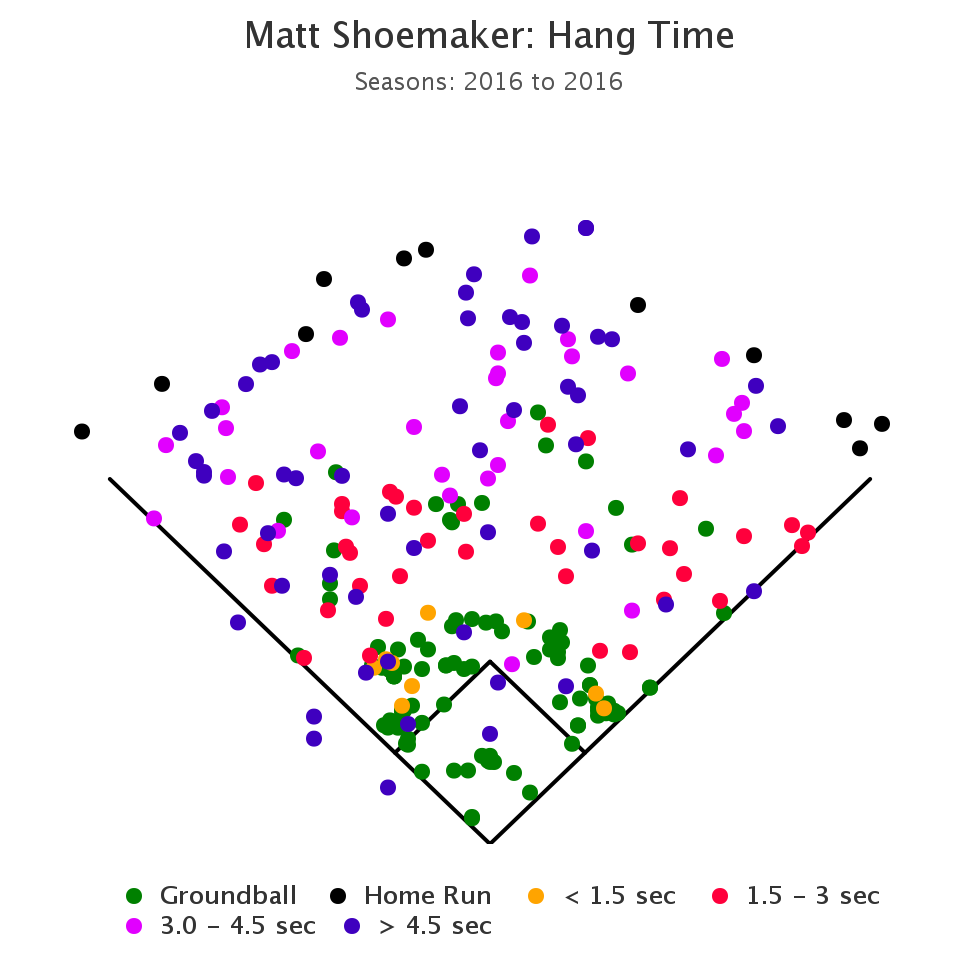
He’s always allowed power in the strike zone and that isn’t likely to change, but with the way he can erase mistakes with strikeouts and limit home run damage by eliminating walks, Shoemaker is well equipped to deal with that flaw. His strikeout-to-walk rate has always been excellent, and he’s on pace for a career high this season. He’s a great target for any strikeout-starved owner; just be prepared to deal with the occasional meltdown and know that he’ll usually balance them out with successful stretches like this one.
To pick him up, I’d drop: J.A. Happ, Jake Odorizzi, Scott Kazmir
Jonathan Schoop | Baltimore Orioles | 2B
It’s been a banner year for second basemen with power. After Brian Dozier was the only second baseman to manage a .200 ISO last season, a resurgent Robinson Cano leads a pack of five players on pace to top that benchmark this year, with MVP candidate Ian Kinsler just a whisper behind (.198 ISO). Cano, Rougned Odor, Daniel Murphy, and Jose Altuve are all universally owned in fantasy, but that fifth player is inexplicably lagging, available in about 40% of both Yahoo! and ESPN leagues.
(Obviously, you know who I’m talking about)
Per Baseball Heat Maps, Jonathan Schoop ranks second among second basemen in average fly ball distance, trailing only Altuve, and based on that fly ball distance, Baseball Heat Maps’ xHR shows he probably deserves about half a homer more than he’s actually hit. So it should come as no surprise that FanGraphs Depth Charts projects Schoop to sock 12 home runs the rest of the way, tied for the most at his position with Cano, Odor, and Neil Walker.
When Schoop is at the plate, fans must keep their heads on a swivel, even if they’re headed out to the concourse for a hot dog.
Schoop was on about a 30-homer pace last season. This year, all he’s done is boost his walk rate, cut his strikeout rate, and bump his batting average by ten points with absolutely no loss of power. He’s maturing into a reliable power producer on a team that’ll give him plenty of opportunities to score and knock in runs. He should be owned just about everywhere.
To pick him up, I’d drop: Addison Russell, Neil Walker, Starlin Castro
3 TO CUT
Players to be traded or dropped, depending on the depth of your league
Eugenio Suarez | Cincinnati Reds | 3B/SS
Of Eugenio Suarez’ 14 home runs, only one has left a yard outside of MLB’s eight most homer-friendly ballparks, per ESPN Park Factors. In addition to the eight he’s hit at home in Great American Ballpark, he’s popped one each in Cleveland’s Progressive Field, Arlington’s Globe Life Park, and Philadelphia’s Citizens Bank Park. When the Reds traveled to Colorado, he stocked up, ringing three dingers off one of the most homer-prone bullpens in baseball.
I can’t fault the guy for taking advantage of his surroundings, but it’s bloated his power numbers. Per ESPN’s Home Run Tracker, five of his 14 bombs have rated “Just Enough”, which is doubly concerning given that all of those homers were hit inside power-friendly parks.
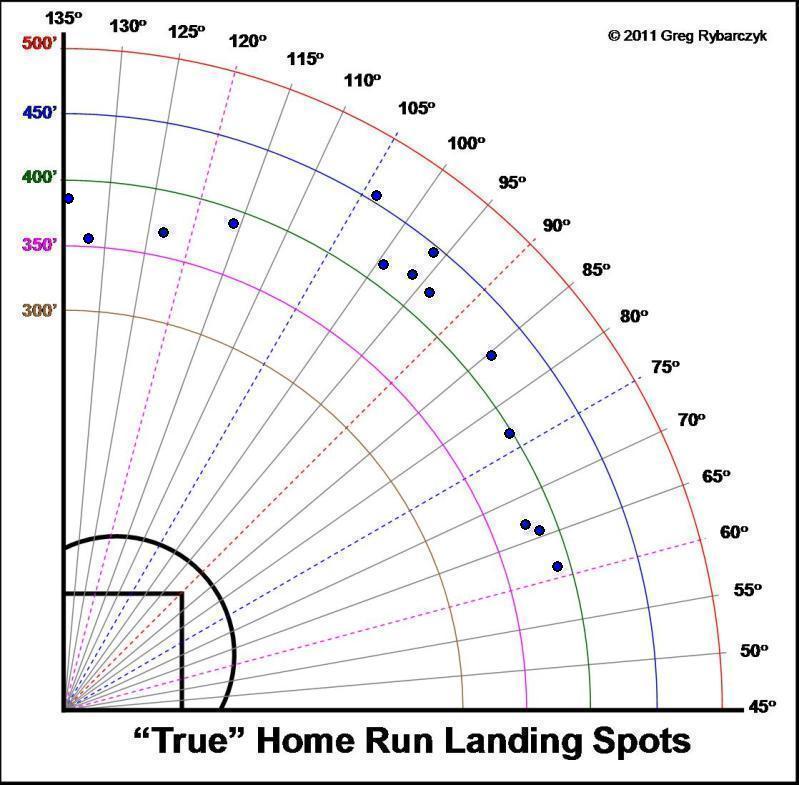
Last year, Suarez hit about twice as many doubles and triples as home runs. Through the first half of this season, that ratio has reversed; he’s managed seven other extra base hits. His 291-foot average fly ball distance is impressive and shows that his jump in round trippers isn’t all luck, but he doesn’t hit enough fly balls to crack 20-plus homers just based on volume. True middle infield sluggers like Story and Espinosa both far outpace Suarez’ 39.3% fly ball rate.
Suarez hits enough flies to maintain a poor batting average, but not enough to balance that with consistently outstanding home run production. I’ll take the under on his FanGraphs Depth Charts projection for 11 homers over the rest of the season.
I’d trade/drop him for: Jhonny Peralta, Jung Ho Kang, Marcus Semien
Max Kepler | Minnesota Twins | OF
Since his promotion from defensive replacement to everyday outfielder, Max Kepler has turned fizzle to sizzle. His numbers for the month of June (he conveniently began his everyday role on June 1) are solid, but boil it down to just the past two weeks, and they become spectacular. Since June 14, he’s slashing .316/.372/.526 with five doubles, a homer (and another on Sunday), and two steals, per FanGraphs.
But a week’s worth Pollockian production does not an A.J. Pollock make.
Kepler was a consensus top five prospect in a consensus top five system, but just about every report pegged the young German as a developmental project. He’s an excellent athlete, but lacks the feel to channel that athleticism into fantasy-relevant production. It showed in the minors, where despite his prospect status, Kepler never hit more than ten home runs or stole more than 18 bases in a single season.
This most recent stretch looks like a breakout, but we can’t ignore the favorable circumstances in which Kepler has reeled of his career best fortnight. He’s faced the Yankees, Angels, and Phillies, all below average pitching staffs by ERA. More than that, the lefty swinging Kepler has faced right-handed starters in eight of those eleven games. The best pitcher he’s faced is the spiralling Aaron Nola (more on him later). Credit to him for taking advantage, but the road won’t always be paved so smoothly.
And even with this hot streak, his aggregate production isn’t all that impressive. On 234 combined PAs between the majors and Triple-A, Kepler has hit four home runs and stolen three bases. Triple that, and his pace is only on the fringes of a 10/10 season. Even with this hot streak, he’s a deep league option at best.
I’d trade/drop him for: Steven Moya, Byron Buxton, Brad Miller
Tim Lincecum | Los Angeles Angels | SP
In honor of last week’s NBA draft, let’s start this bit with a legendary quote from NBA 3-Point Contest champion Jason Kapono:
“I should have left UCLA after my freshman year, played in Croatia, grown a beard and changed my name to Vladimir Kaponovich. That would have been perfect.”
Kapono was referring to the NBA’s seeming preference for mystery-shrouded European phenom like Darko Milicic, but his point is about assumptions tied to names is quite germane to the fantasy relevance of the Angels’ newest starting pitcher. Because if Tim Lincecum’s name wasn’t “Tim Lincecum”, fantasy owners almost certainly wouldn’t pay him any attention. Somehow, we’re treating Lincecum like he just rained jumpers over extended broomsticks in a pre-draft workout, rather than evaluating him like a fifth-year senior who just choked in the NCAA tournament. We’re remembering the peaks without accounting for the fact that he’s been in a valley for a half decade.
I’m rooting for the guy too, but come on people. We didn’t need to see a 1-1 K-BB ratio and 5.00 ERA in his first two starts to tell that he’s not an effective pitcher anymore. His velocity has bounced back a bit, but near 2014 levels. It’s still nearly five miles-per-hour below his mark from 2011, which was Lincecum’s last really productive season.
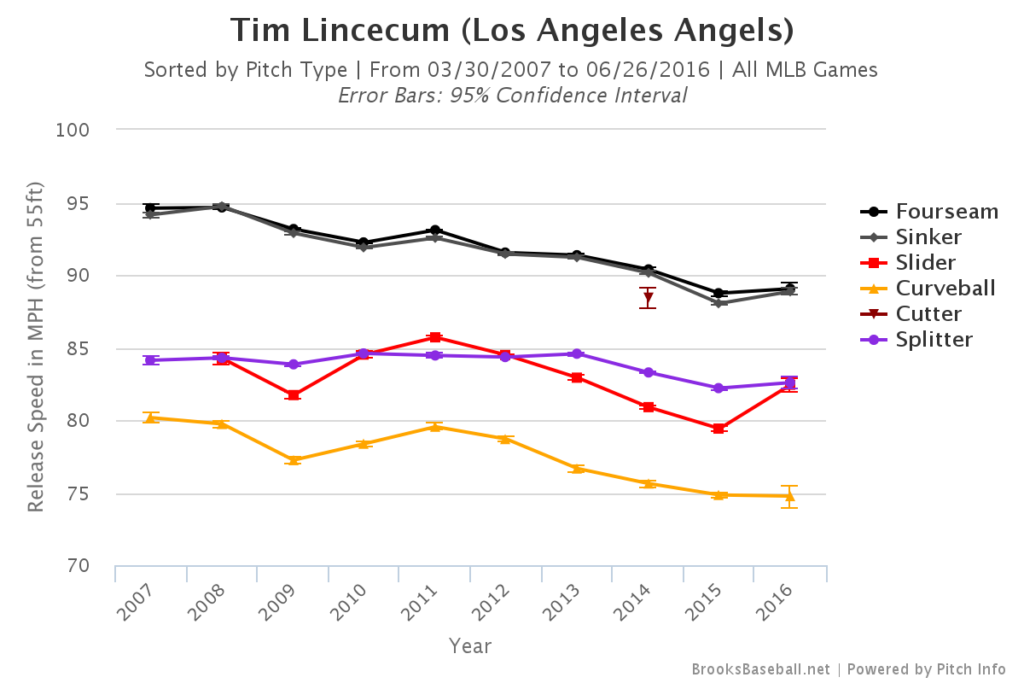
I’ve written quite a bit about leveraging name recognition in your favor, but this is an example of that logic taken to its ugly extreme. After all, a pitcher by any other name would torpedo your ratios as quickly…
I’d trade/drop him for: Blake Snell, Kevin Gausman, Christian Friedrich
3 TO KEEP
Players to hold or trade for; owned in most standard leagues
Willson Contreras | Chicago Cubs | C
I tend not to double up on guys in this column, but Willson Contreras is such a unique situation that I felt he earned a move down to this section. Since debuting back on June 17, he’s maintained an outrageous .348/.464/.783 batting line, with a double and three home runs in just 28 plate appearances. With Miguel Montero entrenched as the day-to-day oversight on the Cubs pitching staff, it seemed like Contreras would only be unleashed a couple times a week, but after quickly establishing himself as one of the better bats in the best lineup in the big leagues, Contreras has forced Joe Maddon’s hand.
In the same spirit as the move that shifted Kris Bryant to the outfield to create room for 3×3 favorite Javier Baez, Maddon told ESPN’s Jesse Rogers that’ll he’ll do whatever it takes to get Contreras on the field as often as possible.
Contreras has been so beneficial to the manager that he’s become a metaphor for breathing.
“It’s like oxygen,” the manager said with a smile. “It’s absolutely necessary, the life he’s brought to the group. He has been a catalyst the last several days.”
Now that he’s got a path to playing time, Contreras should be owned in every league.
Though all three of his home runs have been rated “Just Enough” but ESPN’s Home Run Tracker, most of that has to do with the fact that they’ve all been hit to centerfield or the power alleys. His 399-foot average home run distance is solid and his 102.9 mph average HR velocity is within a few decimal points of the best power hitting catchers in the game. I have no worries at all about his ability to hit the ball over the fence.
I wouldn’t advise dropping somebody like Salvador Perez or Wilson Ramos to pick up Contreras, but even in ten-team leagues, there are at least a couple owners for whom the young Cub would be an upgrade. And the projection systems haven’t adjusted to Maddon’s deployment strategy yet, which might give you a chance to acquire him for what a rival owner might perceive as an overpay. Even if he’s already owned in your league, it’s not too late to buy.
I wouldn’t trade/drop him for: Chris Carter, Brandon Moss, Mike Napoli
Jose Ramirez | Cleveland Indians | 2B/SS/3B/OF
Jose Ramirez has always been talented, he’s just had the bad fortune of being a shortstop on the Cleveland Indians at the same time as Francisco Lindor, the best young shortstop we’ve seen since Alex Rodriguez.
But, smartly, Terry Francona and the Tribe have committed to finding a way to get Ramirez’ bat in the lineup this season. He’s played third base and left field (shouts to Michael Brantley’s shoulder) and delivered about average defense in both positions, which should be more than enough to keep his excellent bat in the lineup, considering that he’s competing with Juan Uribe’s Sandovalian physique at third base and Brantley’s balsa wood joints in the outfield.
At the plate, Ramirez has bounced back from last season’s BABIP-induced disaster while maintaining his growing power and aggression on the basepaths. He’s got a great chance to pop ten home runs and steal 20 bases; only two infielders accomplished that double last season.
His production and plate discipline has regressed a bit in recent weeks, but so has his BABIP, sagging 30 points below the .327 and .329 marks he posted in April and May, respectively. His June line drive rate is actually his highest of any month this season, which portends a speedy rebound and continued success.
I wouldn’t trade/drop him for: Eduardo Nunez, Zack Cozart, Elvis Andrus
Aaron Nola | Philadelphia Phillies | SP
The Phillies are in a spectacular tailspin, with Aaron Nola playing the role of Baloo.
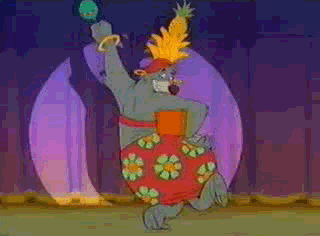
Well… hopefully not that part of the role. Mostly, he’s just been the one driving the plane toward the ground. Nola has been pounded in his last three starts, logging a 15.83 ERA and only a 3.9% swinging strike rate. The bad luck of a .500 BABIP certainly has something to do with those results, but Nola’s not giving up cheapies; he’s been tagged for a 33.3% hard contact rate during this stretch, per FanGraphs.
The results are clearly awful, but the explanation of those results is much much murkier. A quick spin around his Brooks Baseball page shows that none of the changes in velocity and movement on any of his pitches are outside the range Nola’s established throughout his two-year career, aside from the simultaneous disappearance of his changeup and curveball’s bat-missing abilities.
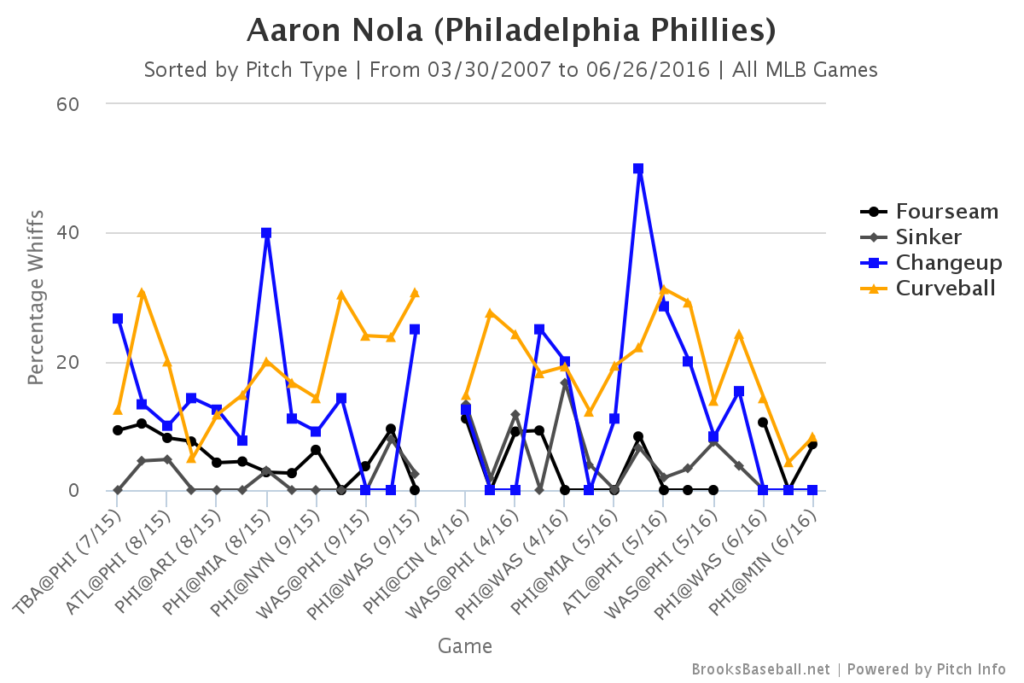
Given that there hasn’t been a clear trend in the velocity or movement on those pitches, I’ve got to believe that it’s a location or deception issue. Nola doesn’t have overpowering stuff, so it makes sense that even a slight hiccup in his delivery could severely impact his ability to consistently fool opposing hitters.
Phillies’ pitching coach Bob McClure is convinced that a few bullpen sessions is all it’ll take to get Nola out of his slump, and I’m inclined to agree. After two months of stellar production, he’s at least earned the benefit of the doubt.
I wouldn’t trade/drop him for: Rick Porcello, Steven Wright, Julio Teheran


